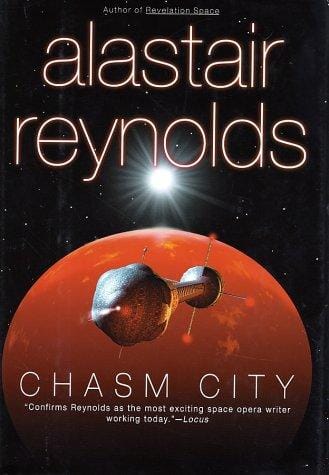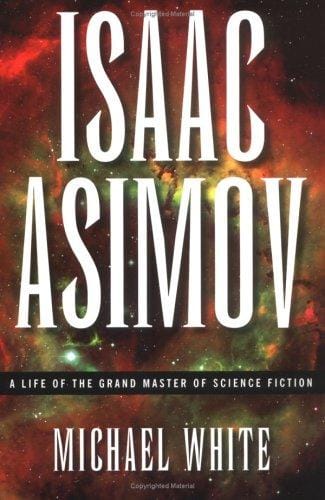Exploring Chasm City: Alastair Reynolds’ Gothic Space Masterpiece
Discover why Alastair Reynolds’ Chasm City remains a must-read blend of noir mystery, hard science fiction, and gothic horror set in the ruined Glitter Band.

Introduction: A Decadent Descent into the Glitter Band
Few science-fiction novels combine noir atmosphere, hard-SF ideas, and gothic horror as effortlessly as Alastair Reynolds’ Chasm City. First published in 2001, the book is technically the second entry in the author’s Revelation Space universe yet works brilliantly as a standalone tale of obsession, memory, and societal collapse. In the two decades since its release, Reynolds’ opus has developed a cult following among readers who crave expansive world-building without sacrificing narrative drive. This article offers a spoiler-light tour of the novel’s core plot, characters, themes, and lasting significance, helping you decide whether to make the plunge into the mist-shrouded canyons of Yellowstone.
Plot Snapshot: From Viral Dreams to Vengeful Quests
The story follows Tanner Mirabel, a former security operative who arrives in Chasm City—once the jewel of the interstellar Glitter Band, now a decaying nightmare—to hunt the aristocrat responsible for his employer’s murder. However, Tanner’s hunt quickly becomes complicated by a virulent nanotech plague known as the Melding, which has warped the city’s architecture into labyrinthine bio-mechanical forms and infected many of its residents with physical and psychological mutations. As Tanner navigates shifting alliances and hallucinatory streets, he begins to experience flashbacks that are not his own, apparently implanted memories belonging to Sky Haussmann, a legendary pioneer revered and reviled in equal measure. These intertwined narrative threads force Tanner to question identity itself even as he closes in on his quarry.
The Setting: Post-Scarcity No More
Before the Melding catastrophe, the Glitter Band represented a utopian orbital society circling the planet Yellowstone, where billions enjoyed post-scarcity abundance granted by ubiquitous nano-fabrication. Reynolds delights in contrasting that prior golden age with Chasm City’s present ruin. Buildings once capable of shape-shifting to meet aesthetic whims now ooze organic tendrils, while once-immortal citizens grapple with sudden decay. Airships hover among mile-deep canyons carved by industrial greed, neon advertisements flicker inside cathedral-like tunnels, and cults worshiping machine angels occupy derelict towers. This richly textured backdrop grounds the novel’s darker philosophical questions in vivid sensory detail.
Character Focus: Tanner Mirabel and Sky Haussmann
Tanner Mirabel’s grizzled determination provides the narrative’s heart. Although outwardly a hardened mercenary, his evolving moral compass invites empathy as revelations about his past surface. Meanwhile, the inserted memories of Sky Haussmann reveal a charismatic yet ruthless colonist whose actions during humanity’s first voyage to Yellowstone ripple centuries later. By weaving these two trajectories together, Reynolds interrogates how myth, propaganda, and selective memory distort our understanding of heroism. Secondary characters—such as the aloof aristocrat Argent Reivich, the shape-changing security chief Zebra, and the plague-infected Satomi—enrich the plot and embody the city’s fractured social strata.
Major Themes: Identity, Decadence, and Technological Hubris
At its core, Chasm City is a meditation on the instability of identity. The memory implants afflicting Tanner force readers to ask whether personal history or present actions define the self. The decaying urban landscape mirrors this psychological erosion, illustrating how societies built on unfettered technological optimism may crumble when underlying ethical foundations rot. Reynolds also critiques elitism: the oligarchs who once flaunted immortality now seal themselves in fortress-like aerostats, clinging to privilege while street-level citizens mutate. Finally, the novel grapples with the unforeseen consequences of exponential tech, cautioning that advancements without robustness or governance can turn utopia into its opposite overnight.
Narrative Structure and Writing Style
Reynolds alternates between first-person chapters in Tanner’s voice and third-person flashbacks chronicling Sky Haussmann’s journey aboard the lighthugger Churl. This dual structure maintains suspense while gradually revealing how past and present intersect. Although steeped in astrophysics and biotechnology, the prose remains approachable, blending brisk action with lyrical flourishes that evoke cyberpunk and space opera in equal measure. The author’s professional background as an astrophysicist lends credibility to relativistic travel mechanics, orbital habitats, and viral nanotech, enhancing immersion without slipping into textbook exposition.
Place in the Revelation Space Universe and the Wider Genre
While newcomers can enjoy Chasm City independently, reading it enriches understanding of events referenced in Revelation Space, Redemption Ark, and subsequent stories. The novel fleshes out the Glitter Band’s downfall, a pivotal historical touchstone for the series’ later cosmic conflicts. In the broader science-fiction canon, Chasm City stands alongside works like William Gibson’s Neuromancer and China Miéville’s Perdido Street Station as a milestone in blending noir aesthetics with speculative world-building. Its Hugo Award win for Best Novel in 2002 cemented Reynolds’ reputation and signaled a resurgence of intelligent, idea-driven space opera in the new millennium.
Why You Should Read It Today
If you’re tired of formulaic sci-fi adventures, Chasm City offers a refreshingly complex experience: a detective revenge plot threaded through an existential puzzle, all situated in a city that feels alive—and dangerously sick. The book invites multiple readings, revealing new layers of symbolism and foreshadowing each time. Audiobook fans will appreciate the atmospheric narration available in recent editions, while collectors can seek out the gorgeous illustrated hardbacks from Gollancz. Ultimately, Reynolds’ fusion of cutting-edge science, rich allegory, and propulsive storytelling ensures that Chasm City remains both culturally relevant and wildly entertaining decades after publication.
Conclusion: Stepping over the Edge
Alastair Reynolds’ Chasm City is more than a spin-off from a popular space-opera series; it is a stand-alone tour de force that examines humanity’s capacity for reinvention in the aftermath of self-inflicted catastrophe. Whether you come for its dizzying skyscraper canyons, morally ambiguous protagonists, or philosophical interrogations of memory, the novel rewards attention with unmatched depth and atmosphere. Take the leap into the Glitter Band’s ruined gem—you may never view the future, or your own sense of self, in quite the same way.



